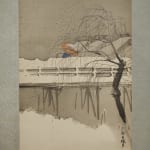Tsuchida Bakusen (1887–1936)
Snow
Color on silk, hanging scroll
Dated 1913
With a box signed by the artist, double boxed
Seal: Bakusen
123.5 x 41.8 cm
209 x 57.5 cm (overall)
Dated 1913
With a box signed by the artist, double boxed
Seal: Bakusen
123.5 x 41.8 cm
209 x 57.5 cm (overall)
Further images
At dusk, snow-covered weeping willow, bridge and houses across the river create a monochromatic world, within which the vermillion hue of the janome umbrella (Japanese umbrella with design of a white ring in the center) gracefully stands out. Possibly depicting a scene in Kyoto, this painting represents an umbrella-holding beauty crossing the wooden bridge heavily cladded with snow over the Kamogawa River or Takasegawa River. The painting inscription “Kichu rogetsu Bakusen sha” indicates that the work was composed in December 1913. In March 1911 after his graduation from Kyoto City School of Arts, Bakusen left the art lecture and discussion group “Le Chat Noir” (Kuronekokai, Black Cat Group) due to disagreement among members, and co-founded “Le Masque” (Kamenkai, Mask Group). Within the same year, his work Kami (hair) was awarded the fifth Bunten (Ministry of Education Art Exhibition) certificate of merit. Bakusen was undoubtedly busy with a range of artistic activities in those years. In 1913 when this painting was composed, Bakusen had an eventful year since the beginning of the year, visiting Nara’s Horyuji Temple in January, travelling to Hachijo-island and Izu Oshima island with Irie Hako and others in February, visiting ama divers in Nagiri-village in Shima, Mie Prefecture in June, and exhibiting one of his signature pieces Ama in the seventh Bunten in October. This work might have been painted in the relatively quiet December, when the artist was able to record such an everyday scene after the full, active year.
Tsuchida Bakusen (nihonga painter; 1887–1936)
Niigata-born nihonga painter. His real name is Kinji. A student of Suzuki Shonen and Takeuchi Seiho. Graduated from the Kyoto Municiple Special School of Painting. Co-founded Kokuga Sosaku Kyokai (Association for the Creation of National Painting) with Murakami Kagaku, Ono Chikkyo, and Sakakibara Shiho in 1918. Active at Bunten (Ministry of Education Art Exhibition) after the dismember of Kokuga Sosaku Kyokai. His work attains a great balance between the Western style and traditional Japanese style, and embraces a sense of gracefulness and freshness. One of the most outstanding nihonga painter of his time. Member of Teikoku Bijutsuin (Imperial Fine Art Academy).
Tsuchida Bakusen (nihonga painter; 1887–1936)
Niigata-born nihonga painter. His real name is Kinji. A student of Suzuki Shonen and Takeuchi Seiho. Graduated from the Kyoto Municiple Special School of Painting. Co-founded Kokuga Sosaku Kyokai (Association for the Creation of National Painting) with Murakami Kagaku, Ono Chikkyo, and Sakakibara Shiho in 1918. Active at Bunten (Ministry of Education Art Exhibition) after the dismember of Kokuga Sosaku Kyokai. His work attains a great balance between the Western style and traditional Japanese style, and embraces a sense of gracefulness and freshness. One of the most outstanding nihonga painter of his time. Member of Teikoku Bijutsuin (Imperial Fine Art Academy).









